Wall Insulation - Looking for Opinions
- Thread starter Nelson
- Start date
-
Active since 1995, Hearth.com is THE place on the internet for free information and advice about wood stoves, pellet stoves and other energy saving equipment.
We strive to provide opinions, articles, discussions and history related to Hearth Products and in a more general sense, energy issues.
We promote the EFFICIENT, RESPONSIBLE, CLEAN and SAFE use of all fuels, whether renewable or fossil.
You are using an out of date browser. It may not display this or other websites correctly.
You should upgrade or use an alternative browser.
You should upgrade or use an alternative browser.
- Status
- Not open for further replies.
There was an interesting evaluation done by the Journal of LIght Construction on air sealing materials including caulks, tapes, etc. One finding that surprised me was that Liquid Nails did a really good job of sealing between different boards and a wiring penetrations. I can attest to how well liquid nails works after tearing out our basement walls for remodeling. The stuff is tough!
That said, there are many good caulks for air sealing out there. I think that main thing to keep in mind is that they do not work well in larger gaps unless you use foam backer.
The JLC article is here (I hope): http://tinyurl.com/ova3mwf
this was a cool article. I'm glad to see that DynaFlex 320 was a good performer. I've been using that stuff for years and love it. Flexible, easy to work with and easy to clean up.
Ok, so after days of racking my brain and reading as much as I could, I am being paralyzed by too much analysis. I'm pulling the trigger on this approach. Quick context - we are in climate zone 6. The wall I'm working on is an exterior wall, fully exposed to the outside but is part of a walk-out basement (this is the wall on the walk out side). Objective is to achieve better thermal efficiency in the wall.
1. Remove existing vapor barrier, drwall and existing insulation (standard fiberglass, best I can tell)
2. Seal all framing edges (where framing meets sheathing on exterior), framing pentrations and top and bottom plates - use DynaFlex 230 for most sealing. Will have spray foam on hand for larger gaps and holes
3. Install Roxul ComfortBatts
4. New drywall - may even seal new drywall to framing if time allows
Hope to start work within a week or two. Will let you know how it goes!
Suggestions, comments or concerns are always welcome so speak up!
1. Remove existing vapor barrier, drwall and existing insulation (standard fiberglass, best I can tell)
2. Seal all framing edges (where framing meets sheathing on exterior), framing pentrations and top and bottom plates - use DynaFlex 230 for most sealing. Will have spray foam on hand for larger gaps and holes
3. Install Roxul ComfortBatts
4. New drywall - may even seal new drywall to framing if time allows
Hope to start work within a week or two. Will let you know how it goes!
Suggestions, comments or concerns are always welcome so speak up!
kennyp2339
Minister of Fire
Ok, so after days of racking my brain and reading as much as I could, I am being paralyzed by too much analysis. I'm pulling the trigger on this approach. Quick context - we are in climate zone 6. The wall I'm working on is an exterior wall, fully exposed to the outside but is part of a walk-out basement (this is the wall on the walk out side). Objective is to achieve better thermal efficiency in the wall.
1. Remove existing vapor barrier, drwall and existing insulation (standard fiberglass, best I can tell)
2. Seal all framing edges (where framing meets sheathing on exterior), framing pentrations and top and bottom plates - use DynaFlex 230 for most sealing. Will have spray foam on hand for larger gaps and holes
3. Install Roxul ComfortBatts
4. New drywall - may even seal new drywall to framing if time allows
Hope to start work within a week or two. Will let you know how it goes!
Suggestions, comments or concerns are always welcome so speak up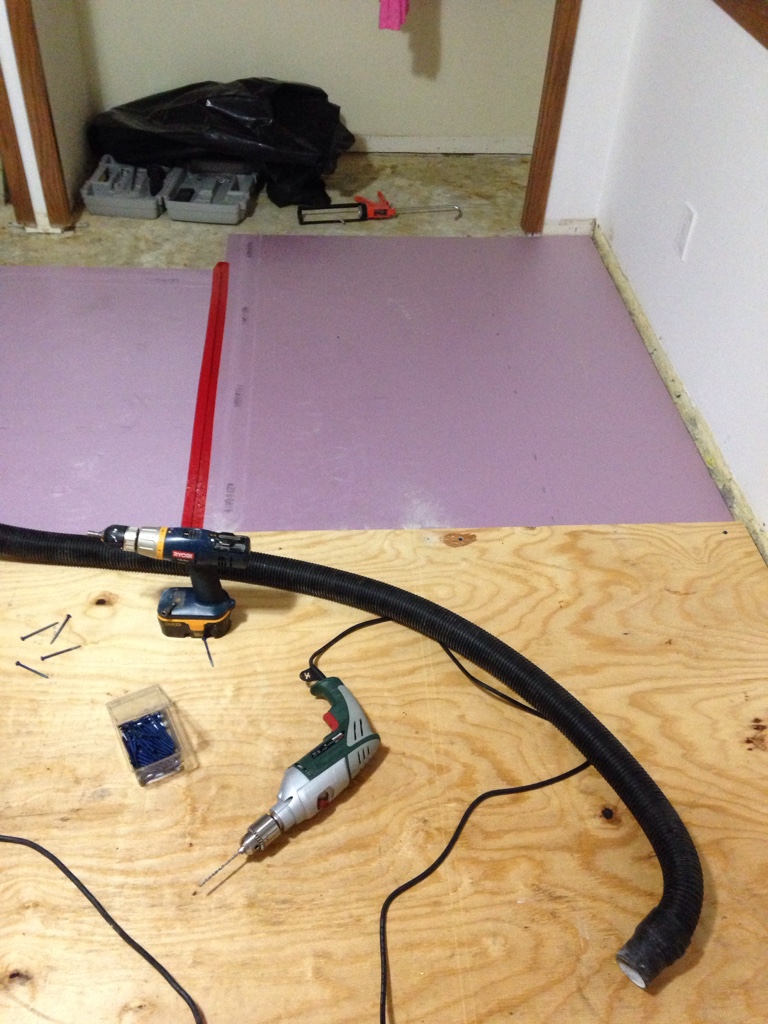
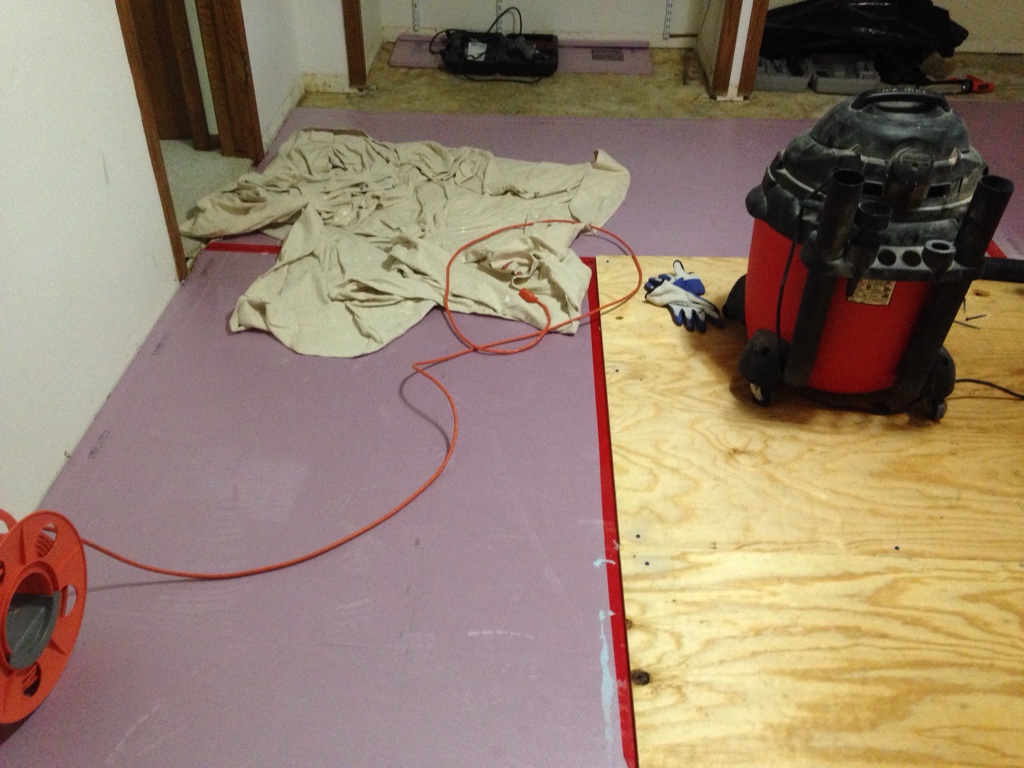
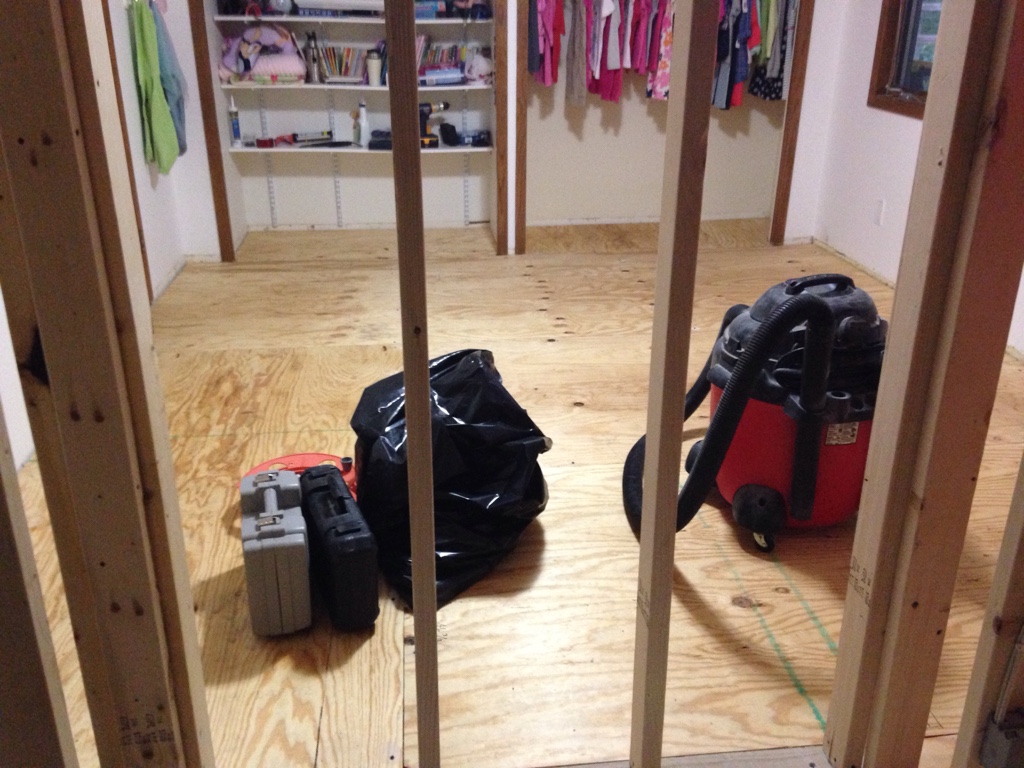
Took about as long as I thought it would - didn't run into any major surprises either. Temp'd a bare spot of concrete (in adjacent bathroom that is being remodeled) and also temp'd the new floor. New floor is 3-4 degrees warmer which is pretty much what I was hoping for. Room is also running 2-3 degrees warmer. Still early, but those results have me very pleased!
Will be working on the walls next weekend with drywall work the follwing week. Will post more pics when I start on the walls.



Last edited:
velvetfoot
Minister of Fire
Nice! Did you really need all that glue with the tapcons? What are you going to put on top?
Good question. I don't know - I'm guessing I could have got away without it but I get a little obsessive about having a sturdy subfloor.
 Putting in tapcons is a little labor intensive so I opted to go with a glue and screw mix to cut down on the number of tapcons.
Putting in tapcons is a little labor intensive so I opted to go with a glue and screw mix to cut down on the number of tapcons.We will be putting carpet on top..
mtrel
Member
Ok, so after days of racking my brain and reading as much as I could, I am being paralyzed by too much analysis. I'm pulling the trigger on this approach. Quick context - we are in climate zone 6. The wall I'm working on is an exterior wall, fully exposed to the outside but is part of a walk-out basement (this is the wall on the walk out side). Objective is to achieve better thermal efficiency in the wall.
1. Remove existing vapor barrier, drwall and existing insulation (standard fiberglass, best I can tell)
2. Seal all framing edges (where framing meets sheathing on exterior), framing pentrations and top and bottom plates - use DynaFlex 230 for most sealing. Will have spray foam on hand for larger gaps and holes
3. Install Roxul ComfortBatts
4. New drywall - may even seal new drywall to framing if time allows
Hope to start work within a week or two. Will let you know how it goes!
Suggestions, comments or concerns are always welcome so speak up!
Don't you need some kind of vapor barrier on the inside?
Don't you need some kind of vapor barrier on the inside?
I'm electing to forgo the vapor retarder/barrier on the inside after doing tons of reading (green building advisor and building science corp) on the subject.
The general consensus is that a vapor barrier is not required on the warm side of the enclosure except for some pretty specific circumstances.
I enjoyed reading this arcticle and the ensuing comments/conversation. Very insightful.
http://www.greenbuildingadvisor.com/blogs/dept/musings/do-i-need-vapor-retarder
http://www.greenbuildingadvisor.com/blogs/dept/musings/do-i-need-vapor-retarder
The insulation part of the project is finished!
Air-sealing....
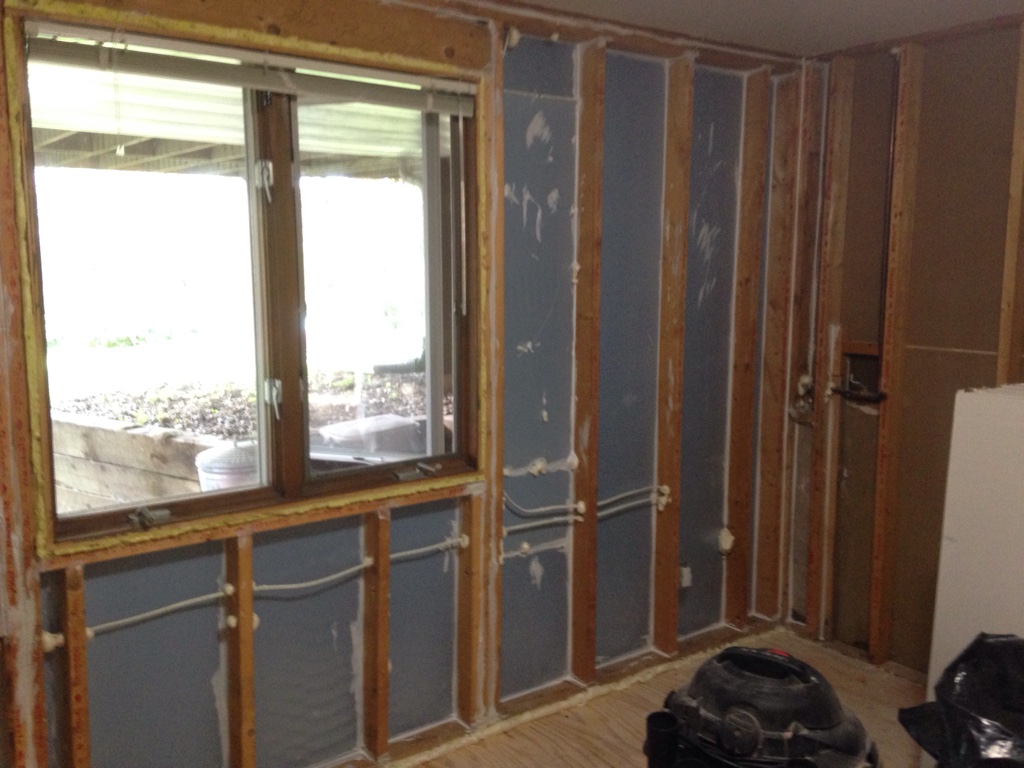
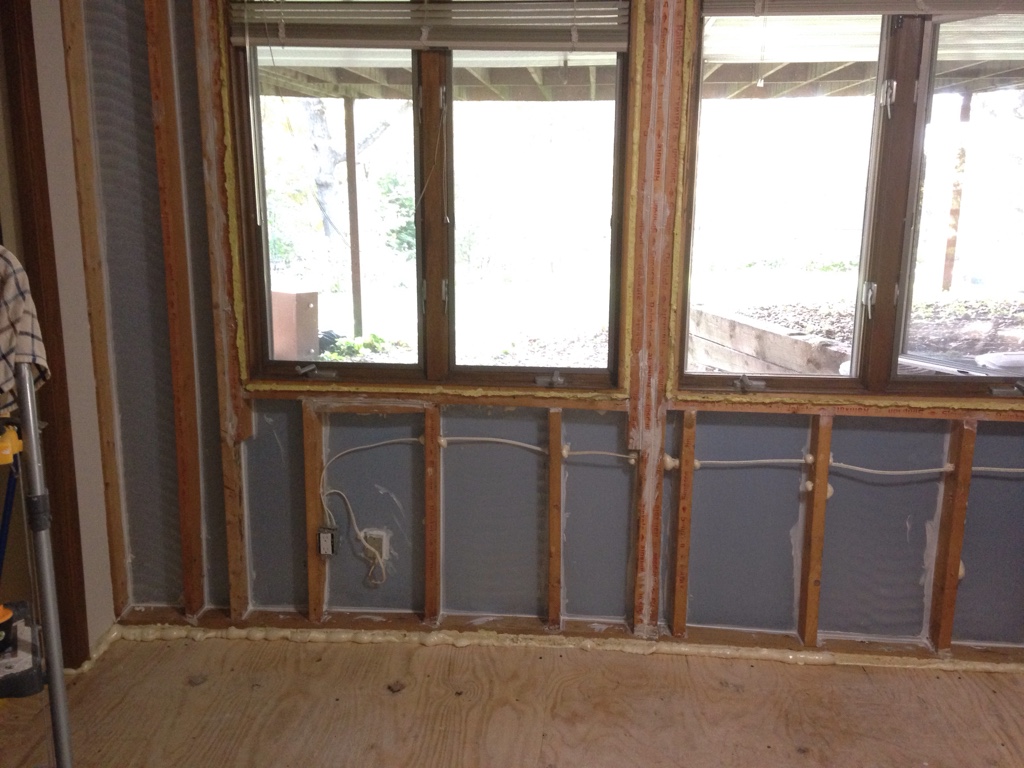
Roxul in...
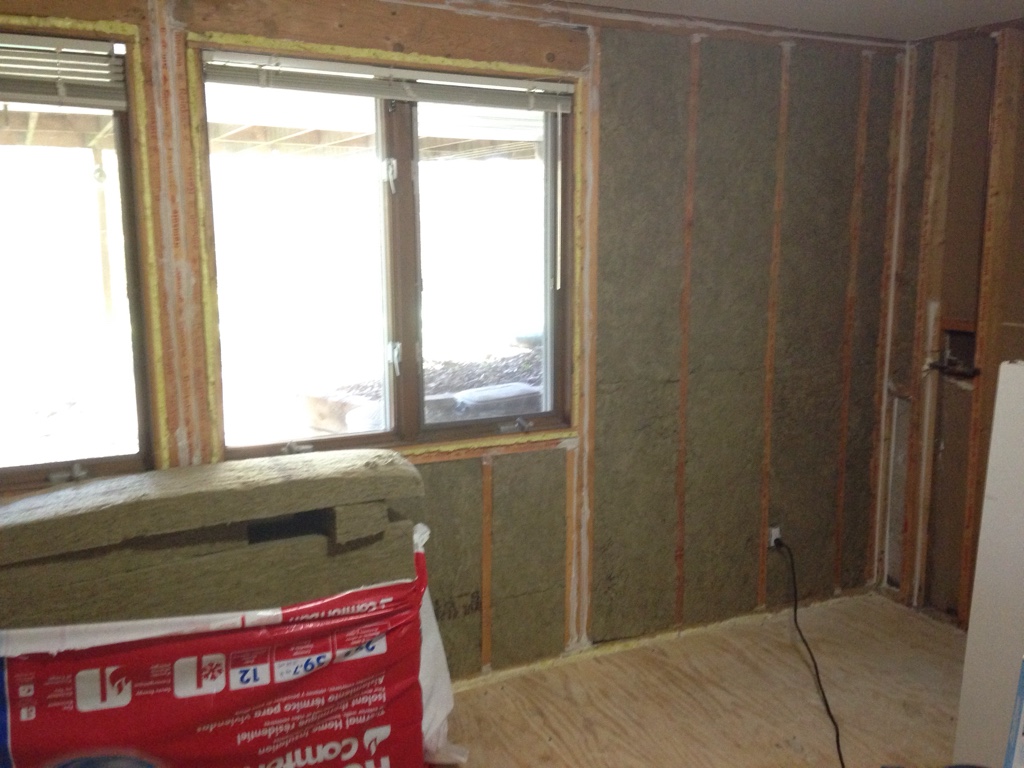
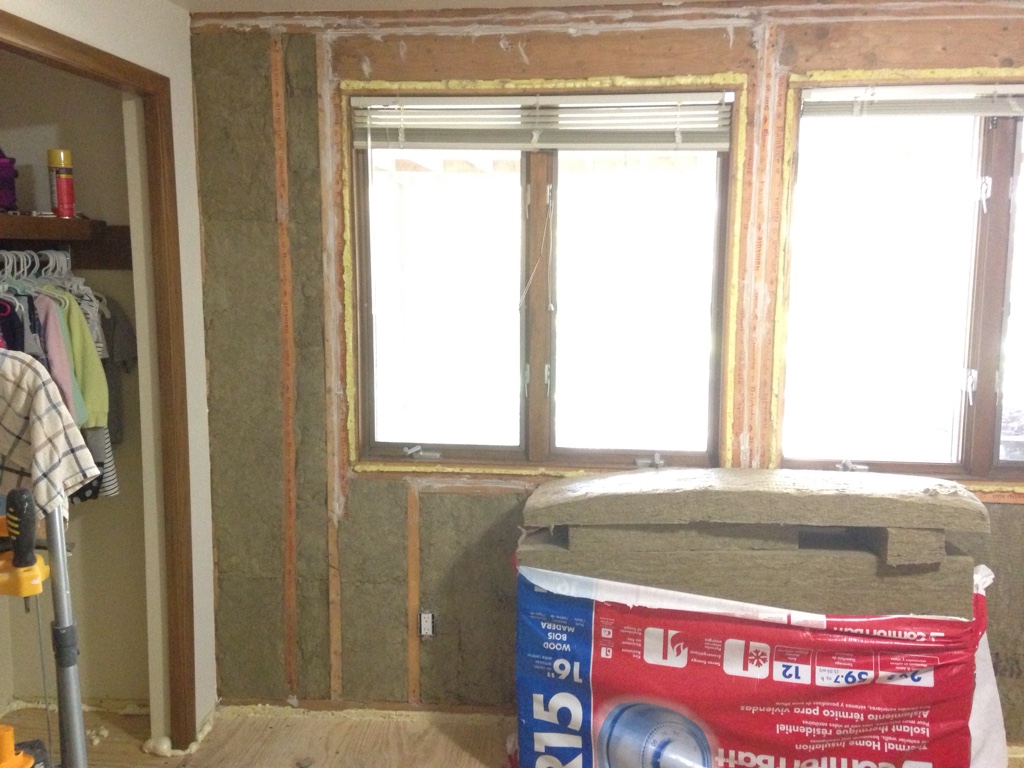
Interesting part of this was that I discovered that there is an inch of foam board on the outside (you can see the blue boards in the first two pics). I wasn't expecting any insulation on the outside as this home was built in the mid-late 70s. I'm guessing they resided at some point and that was when it was added. - foam was right up against the studs so I assume there is sheathing on top of that, on the exterior. A little extra r-value.
Air-sealing....


Roxul in...


Interesting part of this was that I discovered that there is an inch of foam board on the outside (you can see the blue boards in the first two pics). I wasn't expecting any insulation on the outside as this home was built in the mid-late 70s. I'm guessing they resided at some point and that was when it was added. - foam was right up against the studs so I assume there is sheathing on top of that, on the exterior. A little extra r-value.
velvetfoot
Minister of Fire
Did you fill the edges of the foam with great stuff or caulk?
I used caulk to seal the edges between the 2xs and the exterior foam. I'm glad I did because it's tough to get a flat edge on the foam which would have prevented the roxul from laying flat against the foam.
btw, for any of you reading this and planning on insulating the floor like I did - pay close attention to the direction lever on your hammer drill. On mine, the direction lever is right above the trigger. I went through at least 3 bits before I realized I had the direction lever in reverse! ugh!
velvetfoot
Minister of Fire
You would've probably had to wait a while til it cured and then trim it with a knife-more work.
Exactly - which isn't impossible but surely a pain and more work. Plus, I like the fact that I was able to tool the caulk and make sure I got a nice seal. It can be more difficult to seal up really small gaps with the spary foam in a can as it's hard to control. Probably not as much of an issue with a pro applicator where you can get a nice even bead.
velvetfoot
Minister of Fire
Yeah. I felt the same. The trick for the foam would probably is to not have such a narrow gap, but I have an obsessive need to get it to fit as tight as possible which doesn't work well with that concept. Then it expands while it cures.
Isaac Carlson
Minister of Fire
I have never been a fan of fiberglass. It is messy, itchy, expensive for what you get and it is very drafty. Anything else is better. 

semipro
Minister of Fire
There may be no sheathing outside the foam. Sheathing is only needed for attachment of siding and a water/wind barrier, and for prevention of racking. Siding can be attached to the studs, or better yet furring strips attached to the studs, to create a drainage plane. Foam may serve as water/wind barrier though house wrap may be installed under the siding or furring strips. Using foam this way, wood sheathing is primarily needed only in the corners to prevent racking.Interesting part of this was that I discovered that there is an inch of foam board on the outside (you can see the blue boards in the first two pics). I wasn't expecting any insulation on the outside as this home was built in the mid-late 70s. I'm guessing they resided at some point and that was when it was added. - foam was right up against the studs so I assume there is sheathing on top of that, on the exterior.
Edit: foam installed this way helps prevent thermal bridging through the studs.
There may be no sheathing outside the foam. Sheathing is only needed for attachment of siding and a water/wind barrier, and for prevention of racking. Siding can be attached to the studs, or better yet furring strips attached to the studs, to create a drainage plane. Foam may serve as water/wind barrier though house wrap may be installed under the siding or furring strips. Using foam this way, wood sheathing is primarily needed only in the corners to prevent racking.
Edit: foam installed this way helps prevent thermal bridging through the studs.
cool, thanks for the info. I didn't have time to thoroughly poke around to see what was on the outside of the foam. Not sure it matters a whole lot from a thermal perspective - the sheathing certainly provides very minimal r-value and is vapor permeable.
Looking forward to some cold weather to see how things work out!
iron
Minister of Fire
sorry i'm late to the thread, but i am also thinking of doing something very similar to nelson. for my spray foam, i was planning to use this: https://www.sprayfoamkit.com/ basically, a CCF. you can buy propane-sized tanks and it comes with the applicator gun. install should be easy enough, minus the keeping the wall temps at a certain level (65?)
does anyone have thoughts on that product?
nelson, for your floor, have you noticed "potato chipping" resulting from only a single layer of plywood? i read threads that talked about using (2) layers of 1/2" plywood and staggering the seams. this would theoretically stop the edges from popping up.
a quick response would be appreciated. i am planning to install new stair stringers this weekend and had planned to allot 2" for the thickness of the basement floor (2 x 1/2" for plywood and 1" thick XPS foam).
thanks!
does anyone have thoughts on that product?
nelson, for your floor, have you noticed "potato chipping" resulting from only a single layer of plywood? i read threads that talked about using (2) layers of 1/2" plywood and staggering the seams. this would theoretically stop the edges from popping up.
a quick response would be appreciated. i am planning to install new stair stringers this weekend and had planned to allot 2" for the thickness of the basement floor (2 x 1/2" for plywood and 1" thick XPS foam).
thanks!
Iron - I haven't noticed any potato chipping on the floor. I glued the foam to the conrete and then glued and tapcon'd the plywood to the foam. It's really sturdy. I made sure to put screws in around the corners to try and prevent and board from popping up.
The issue I have is that I don't have a ton of ceiling height to play with so I didn't want to add an extra 1/2-5/8" of an inch. If you have the headroom, it wouldn't hurt to put the second layer of plywood down. It goes down pretty quickly.
What type of flooring are you putting over the plywood?
FYI - I didn't put the carpet down on my floor for a few weeks and I didn't notice any edges moving at all during that time.
Good luck!
The issue I have is that I don't have a ton of ceiling height to play with so I didn't want to add an extra 1/2-5/8" of an inch. If you have the headroom, it wouldn't hurt to put the second layer of plywood down. It goes down pretty quickly.
What type of flooring are you putting over the plywood?
FYI - I didn't put the carpet down on my floor for a few weeks and I didn't notice any edges moving at all during that time.
Good luck!
Are you planning to foam the entire cavity of your walls or are you just using foam for sealing the edges?
iron
Minister of Fire
thanks nelson. i have also thought of using 1/2" plywood for the base, then a 1/8" underlayment to cover those seems. figured that would eliminate any potato chipping. we do have full height ceilings, so losing the extra is NBD. but, there would be less of a trip point coming from the garage into the basement, so it would be better to stay thin.
planning to put down carpet as well.
for the foam, i was planning to do 2" thick for the entire cavity. it's been awhile since i looked at pricing, but i felt like that would come to $2k in insulation costs and would give me a nice enough R-value, compatible to the 2x4 walls in the upstairs. tempting to go thicker, but ultimately, i think there will be significant improvement simply by reducing the drafty air coming off the concrete. the previous owner that built the existing walls didn't insulate. when i replaced the outlets downstairs, it was a stream of cold air pouring in between the gaps.
the real question for me is whether i demo the existing walls so that i can create a thermal break between concrete and studs or just leave it as is (which i don't know what it is yet since i haven't opened the walls)
planning to put down carpet as well.
for the foam, i was planning to do 2" thick for the entire cavity. it's been awhile since i looked at pricing, but i felt like that would come to $2k in insulation costs and would give me a nice enough R-value, compatible to the 2x4 walls in the upstairs. tempting to go thicker, but ultimately, i think there will be significant improvement simply by reducing the drafty air coming off the concrete. the previous owner that built the existing walls didn't insulate. when i replaced the outlets downstairs, it was a stream of cold air pouring in between the gaps.
the real question for me is whether i demo the existing walls so that i can create a thermal break between concrete and studs or just leave it as is (which i don't know what it is yet since i haven't opened the walls)
The nice thing about spray foam is that you get the insulating factor and air sealing in one application. Air sealing is big so you want to get that right, obviously. I think 2" of foam would get you to about 13 r-value. I used Roxul batts (for 2x4 walls) and that is 15 r-value. I haven't done the cost comparison between foam and roxul but I seem to recall someone here posted it.
Are you doing the foam DIY or having someone do it for you?
I considered having someone spray foam for me since I was doing a relatively small section of wall but the timing of other projects pushed me to do the air seal and roxul route. We haven't had any really cold temps at this point, but I have been really happy with the performance. My walls are staying about 64F when the temps are in the 30s outside. At one point last year, when it was in the single digits, I measured the walls in that room and they were running in the 40s! Can't wait for some real cold temps to see how the walls are.
Are you doing the foam DIY or having someone do it for you?
I considered having someone spray foam for me since I was doing a relatively small section of wall but the timing of other projects pushed me to do the air seal and roxul route. We haven't had any really cold temps at this point, but I have been really happy with the performance. My walls are staying about 64F when the temps are in the 30s outside. At one point last year, when it was in the single digits, I measured the walls in that room and they were running in the 40s! Can't wait for some real cold temps to see how the walls are.
- Status
- Not open for further replies.
Similar threads
- Replies
- 15
- Views
- 863
- Replies
- 61
- Views
- 4K
- Replies
- 7
- Views
- 887
- Replies
- 5
- Views
- 491
- Replies
- 3
- Views
- 290

